| Step 1 - Skin Preparation: None |
 |
| |
| No skin
preparation is required. Under no circumstances should
alcohol be applied to the skin prior to vaccination as it has been shown
to inactivate the vaccine virus. |
| |
| Step 2 - Dip Needle |
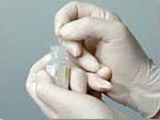 |
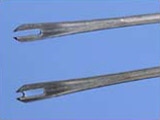 |
|
|
| The
needle is dipped into the vaccine vial and withdrawn. The needle is designed to
hold a minute drop of vaccine of sufficient size and strength to ensure a take
if properly administered. |
| |
|
Step 3 - Make 15 Perpendicular Insertions
within a 5mm Diameter Area |
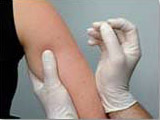 |
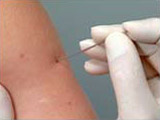 |
|
|
The
needle is held perpendicular to the site of insertion. The wrist of the
vaccinator should be maintained in a firm position (*) by resting on the arm of
the vaccinee or other firm support.
Fifteen perpendicular insertions are made in rapid order in an area
approximately 5 mm in diameter.
Strokes should be vigorous enough to evoke a trace of blood at the site after
15-30 seconds.
The bifurcated needle is for single usage only and should be discarded in an
appropriate biohazard container immediately after vaccinating each patient.
Caution: Needles should never be dipped into the vaccine vial more than
once, in order to avoid contamination of the vial. |
| |
|
| Step 4 - Absorb Excess Vaccine |
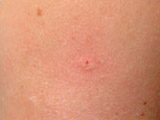 |
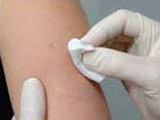 |
|
|
| After
vaccination, excess vaccine should be absorbed with sterile gauze. Discard the
gauze in a safe manner (usually in a hazardous waste receptacle) in order not
to contaminate the site or infect others who may come in contact with it.
|
| |
|
| Step 5 - Cover Vaccination Site |
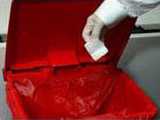 |
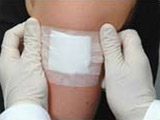 |
|
|
It is
important that the vaccination site be covered to prevent dissemination of
virus.
Recommended covering:
• Sterile gauze loosely held down by tape (†)
Other coverings that have been used:
• Perforated plastic bubble
• Semipermeable membrane occlusive dressing (§) |
| |
| Step 6 - Caution Vaccinee and/or Guardian |
To
avoid contact transmission of the virus, vaccinees and guardians must be
cautioned:
• No rubbing or scratching of vaccination site
• Discard gauze carefully
• Wash hands thoroughly after handling gauze
For further information on preventing dissemination of virus, please visit the
Preventing
Contact Transmission page.
Accidental Administration by Oral or Parenteral Route
Ingestion and intramuscular injection of a dose of vaccine are NOT recommended
routes of administration. However, no harm has been recorded from such events.
For further information please visit the
Accidental
Administration page. |
| |
* When
vaccinating infants or children, it may be necessary to appropriately restrain
the child to avoid accidents during administration.
† Some also advise pinning an additional piece of sterile gauze to
clothing over the vaccination site.
§ In recent trials, a semipermeable membrane occlusive dressing resulted
in a macerated lesion in a number of vaccinees and may increase the risk of
secondary bacterial infection. |

